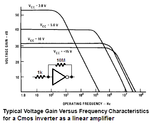parkpika
Junior Member level 3
I've heard that you can generate a square wave from a sine wave using an inverter chain. Why does this work?
The voltage characteristic of an inverter looks more like a curve, not a step. Does cascading inverters help it look more like a step? why??
Thanks
The voltage characteristic of an inverter looks more like a curve, not a step. Does cascading inverters help it look more like a step? why??
Thanks
